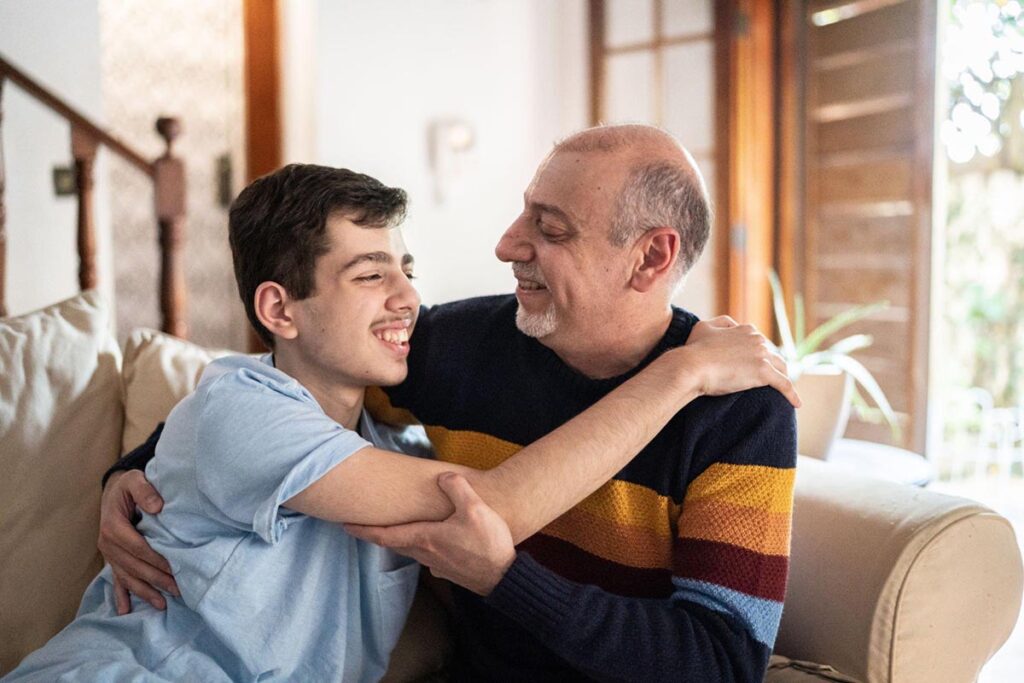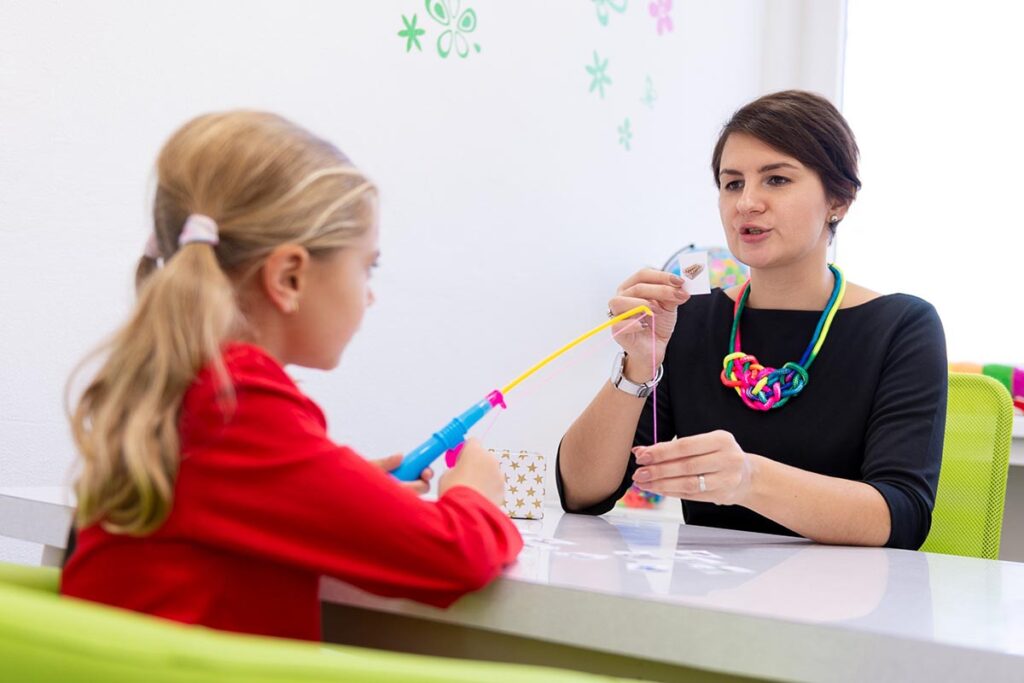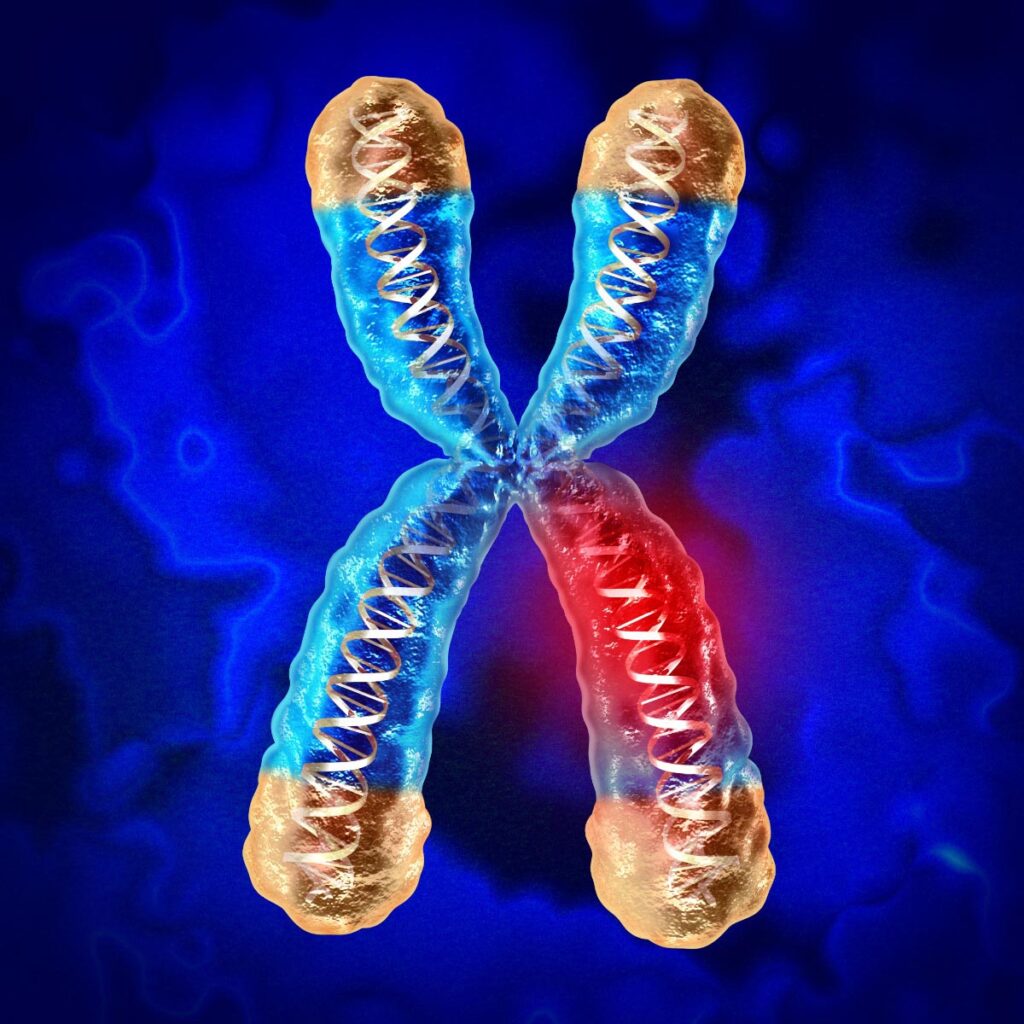What is Fragile X Syndrome?
Fragile X syndrome, also known as Martin-bell syndrome, occurs due to a mutation of the FMR1 gene in the X chromosome. Whilst all people have the FMR1 gene in the X chromosome, sometimes a mutation occurs and results in cognitive and physical differences in a person. These variations can sometimes affect communication and human development.
The name Fragile X syndrome comes from the distinctive shape of the X chromosome. When seen under the microscope, part of the X chromosome looks different or “fragile”.
The genetic variation can be inherited from both parents, and experts are unsure how many people carry the fragile X premutation. Research suggests that 1 in 4,000 males and 1 in 8,000 females may be born with Fragile X mutation in the UK.
Children and adults with FXS might have learning and behavioural challenges, mild to moderate intellectual disability, and distinctive physical features. However, they still have an array of skills and talents, can live independently and live a meaningful life in the community. Some people, though, might need more regular assistance and care.
Fragile X Syndrome Symptoms
The word syndrome in Fragile X syndrome might convey a negative anticipation and a concerning message for parents and families of a child with FXS. The variation involves a different functioning of an individual’s brain compared to the “neurotypicals” around them.
Learning the FXS traits on time allows early evaluation and proper support from a young age, resulting in significant progress in learning, education and employment.
Fragile X Syndrome Characteristics
Before learning the common FXS symptoms, let’s unlock the wide range of endearing characteristics of people with fragile X syndrome:
- Positive
- Kind
- Friendly
- Sense of Humour
- Prominent visual and long-term memory skills
- Attentive
- Helpful
- Affectionate
Fragile X Syndrome Challenges
On the other hand, children with Fragile x syndrome might experience challenge in several neurodevelopmental areas that can result in:
- Difficulty learning to sit, crawl or walk
- Trouble with speech and language (delayed speech)
- Poor eye contact
- Unusual hand flapping
- Lack of impulse control
- Hypersensitivity to sounds and light
- Difficulty paying attention
- Hyperactivity and temper tantrums
- Anxiety
- Depression
- Challenging behaviour, especially in boys
- Lack of socialisation skills
- Obsessive-compulsive behaviours
- Seizures
- Attention deficit hyperactivity disorder (ADHD)
- Autism characteristics related to communication and social interaction
- Learning Disabilities
- Intellectual disabilities
- Developmental delay
- Developmental disability
Physical Features of People with FXS
Generally, people with Fragile X syndrome share several physical characteristics regarding body shape and facial features, including:
- Large head
- Longer and oblong-shaped face
- Strabismus (crossed eyes)
- Larger size of the ears
- Low muscle tone
- Soft skin
- Larger size of the chin and forehead
- Joint hypermobility (loose joints)
- Fallen arches
Behavioural Characteristics of People with FXS
Behavioural characteristics of people with Fragile X syndrome include a range of loving personality traits and relatively adjustable skills in addition to challenging behaviour. Types of behaviour challenges can vary in individuals with FXS and mainly depend on the influences and triggers from the social environment.
Specific factors may intensify the challenging behaviour in people with Fragile X syndrome. It is essential to assess the potential triggers behind behavioural excitation with a proper and tailored approach.
Possible behaviour challenges that a person with Fragile X syndrome might experience include:
- General anxiety
- Social interaction challenges
- Trouble with communication skills
- Fear and excitation caused by social stimulation
- Repetitive speech or movements caused by social triggers
- Physical symptoms like blushing, redness in the ears or sweating in the palms as a result of social stimulation
- Social withdrawal and fear of social interactions
- Hypersensitivity to loud sound, light or fabrics
- Attention deficit and hyperactivity
Effects of Fragile X Syndrome
Fragile X syndrome appears naturally and manifests differently in every individual. Adults and children with Fragile X syndrome might experience various intellectual and developmental disabilities. Whilst fragile x syndrome affects both males and females, it is said that affected females often come with milder symptoms.
- Developmental delays
- Developmental disabilities
- Learning difficulties
- Intellectual disability
- Social and behavioural challenges
- Sleeping difficulties

What Causes Fragile X Syndrome?
Fragile X syndrome appears due to a variation in the FMR1 gene (Fragile X Messenger Ribonucleoprotein 1) that is normally present on the X chromosome. The gene is responsible for producing a protein named FMRP. The role of this protein is to create and maintain normal signal transmission between the nerve cells in the nervous system. In the case of FMR1 mutation, the body produces little or no FMRP, which might result in Fragile X syndrome.
However, not every mutation in the FMR1 gene causes Fragile X syndrome, as there are other ways in which our body produces the neurotransmitting protein. Several factors determine whether a person will be born with Fragile X syndrome and the range of characteristics within a person.
- Degree of mutation– Many people have a smaller number of repeating changes in the FMR1 gene, whilst some have a larger number of repeating alternations in the gene. The body can somewhat compensate for the protein in small-scale mutations, resulting in milder general variations.
- The number of cells carrying the mutation– The cells in the human body are diverse by nature, and some might carry the FMR1 mutation while others do not. If the mutation affects most of the cells in the body, the individual is likely to have characteristics of FXS. If the alternations are present in a smaller number of cells, the person may have just mild or no characteristics of Fragile X syndrome.
- Having two X chromosomes– Unlike males with one X and one Y chromosome, females are born with two XX chromosomes. If the mutation occurs in the FMR1 gene on one X chromosome, the other X chromosome may not carry the mutation. In case of a significant gene mutation, the female body can still produce some amounts of FMRP, which typically results in milder characteristics.
Is Fragile X Syndrome Hereditary?
Fragile X syndrome is a genetic variation that can be passed down from a parent to a child. In most cases, people with Fragile X syndrome have more copies of a DNA chunk called CGG. Typically, the chunk CGG repeats five to 40 times. In individuals with FXS, this DNA segment repeats over 200 times. The number of repeats is directly related to the presence of characteristics. For example, the more the CGG repeats, the more prominent genetic variations are.
A mother with premutation has a 50% chance of passing the FMR1 gene to children in both genders. A father can pass the affected gene only to his daughters, while the sons will receive the Y chromosome, which is not the FXS carrier. Boys are more susceptible to receiving the Fragile X syndrome gene and typically have more prominent symptoms.
Diagnosis of Fragile X Syndrome
Children who show characteristics of developmental delays or some distinctive physical features, especially in the head or face, might need to undergo FXS testing. In boys, Fragile X syndrome evaluation is established around 35 to 37 months old, whilst in girls, around 42 months. In most cases, the differences might be noticed as early as 12 months.
The FXS evaluation is made with a standard DNA FMR1 blood test. The analysis detects alternations in the FMR1 gene related to the Fragile X syndrome. The results may indicate further examination depending on the needs of the individual. If the doctor confirms the presence of FXS, genetic counselling may greatly help explain the genetic variation and how to manage it successfully.
Is Fragile X Syndrome Permanent?
FXS is a lifelong diversity, and although it doesn’t have a cure, early evaluation and an individualised approach will help people reach their full potential. Emotional and family support is crucial for the physical and mental well-being of a person with FXS.
Can Fragile X Syndrome be Prevented?
Fragile X syndrome is a genetic variation and cannot be prevented. Whilst there are some prenatal DNA tests like amniocentesis and chorionic villus sampling. However, prenatal screening is not recommended and should be avoided due to the following reasons:
- Test reliability- Sometimes, prenatal FXS tests may show positive results, and the baby doesn’t develop any of the symptoms
- The test can cause unnecessary concerns to future moms.
- There is no supported evidence that prenatal tests will result in better outcomes in babies in contrast to ordinary healthcare
Management and Treatment
Many methods can significantly improve the emotional, intellectual and physical functioning of people with FXS. Whilst there is no permanent cure, with early intervention strategies, children and adults with FXS have shown outstanding results in education and employment. The proper support can significantly improve people’s learning and social skills, and some have full-time jobs.
Typical methods for supporting people with FXS include:
- Learning education programme (IEP and 504)
- Occupational therapy
- Behavioural therapy
- Speech and language therapy
- Specific medicines depending on the individual
Successful management of FXS requires constant and regular cooperation between the family members, doctors, school and healthcare providers.

Fragile X Syndrome and Autism
FXS is a genetic mutation syndrome. Autism is a spectrum of neurodevelopmental differences that affect a person’s social, learning and behavioural skills. Typically, FXS evaluation is made through a DNA test, whilst specific social and behavioural criteria detect autism.
Studies show that FXS-affected individuals are likely to have autism as well. Fragile X syndrome might cause autism spectrum disorder in some cases. Some results also link the incidence of both FXS and ASD with susceptibility to sleeping difficulty, seizures, and behavioural challenges.
Other Related Conditions with FXS
Fragile X syndrome is a member of the fragile X family. The other two related syndromes include:
Fragile X-associated tremor ataxia syndrome (FXTAS) appears later in life, usually after age 50. According to experts, tremor ataxia syndrome is more likely to appear in males. Common symptoms include:
- Struggle with balance gait difficulties
- Tremor and shaking in the hands
- Frequent mood changes
- Cognitive difficulties
- Numbness in the arms and legs

Living with Fragile X Syndrome
Several factors, including early assessment, proper approach and humanised care, significantly impact the quality of life of people with FXS. A child with Fragile X syndrome can regularly attend school but will probably need individual accommodation and learning plans.
Most schools provide the best possible conditions for children with intellectual and social challenges, along with highly trained professionals. Sometimes, a child might also need learning care and support at home.
Early intervention allows children to learn to read, gain new skills, and implement new ideas. Most women with FXS can earn at least a high school diploma, maintain a full-time job, and live independently. Most men with Fragile X syndrome need regular support in their everyday activities. Some of them can accomplish a high school diploma and find full-time employment.
Finally, treating people with dignity, respect, and compassion is the “cure” that everybody needs.
How Leaf Complex Care Supports People with Fragile X Syndrome
If you have a child or a family member with Fragile X syndrome, you’ll probably opt for all-encompassing and tailored care support. At Leaf Complex Care, we provide much more than basic daily needs. We build human relationships with our empathic approach and positive behaviour strategies.
We embrace the difference and promote acceptance, humanity and respect. Our team of professional support workers design a personalised and bespoke care plan adjusted to the individual’s needs. We deliver tailored accommodation and help implement learning and educational programmes. Our goal is to build people’s strengths and skills, help them chase their dreams, and become full citizens in the community.
For more details, contact us now.

